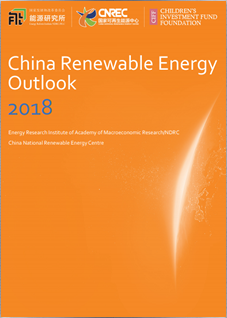China Renewable Energy Outlook 2018 (CREO 2018)
The China Renewable Energy Outlook 2018 (CREO 2018) is guided by the strategic thinking from the 19th National Congress of the Communist Party of China held in Beijing, between 18 and 24 October 2017, and implements the 13th Five-Year Plan development guidelines in detail, aiming to “build a clean, low-carbon, safe, and efficient energy system.” It demonstrates the feasible path and necessary steps for the transformation of China’s energy system from fossil fuel to renewable energy.
Main findings
Fossil fuel usages peak in 2020
It is possible and beneficial for China to reach peak utilisation of fossil fuels in 2020, and to see usage decline steadily towards 2035 (see figure 1). Coal’s share should decline in the power and industrial sectors. Electrification of transport and industry will slow, and then halt, the growth in China’s oil consumption and imports. China will not require gas as a bridge between coal and renewable energy.
Strong wind and solar power boost from 2020
With improved economics, the deployment of solar and wind power can increase significantly in the next 10 years. New annual solar PV installation could reach 80-160 GW and wind 70-140 GW per year (see figure 2). These sources become the core of the nation’s energy system by 2050.
Energy efficiency and electrification of end-use sectors
The reform of the supply sector should be coupled with a transformation of end-use sectors through energy efficiency measures and a large-scale electrification of the industrial and transport sectors.
Key recommendations
Policy measures and institutional frameworks need to align with long-term clean energy ambitions. ç¡
Strictly enforce coal reduction
Efforts to reduce coal usage must be accelerated by halting new coal power, promoting electrification in industry and clean heating in buildings, efficiently pricing carbon, and providing targeted support to coal-dependent provinces for energy and economic transition.
Create a level playing field for renewable energy
The current barriers for promoting renewable energy must be removed by improving coordination between authorities, giving adequate incentives for developers, derisking investments, and rapidly implementing power markets that work for renewables.
An institutional reform process towards ecological civilisation
The 19th Party Congress emphasised the overall targets towards 2050 of building an ecological civilisation. These ambitions must be anchored in all administrative levels. The power sector reform must ensure that the incumbent players become driving forces for renewables, that grid companies develop planning methods to ensure full uptake of variable renewables, and that local governments have strong motivation to take a proactive role in the transformation process.
Details
- Source: China National Renewable Energy Centre
- Source Link: http://www.cnrec.org.cn
- Publication Date: 11/2018
- Country: China
- Language: English
